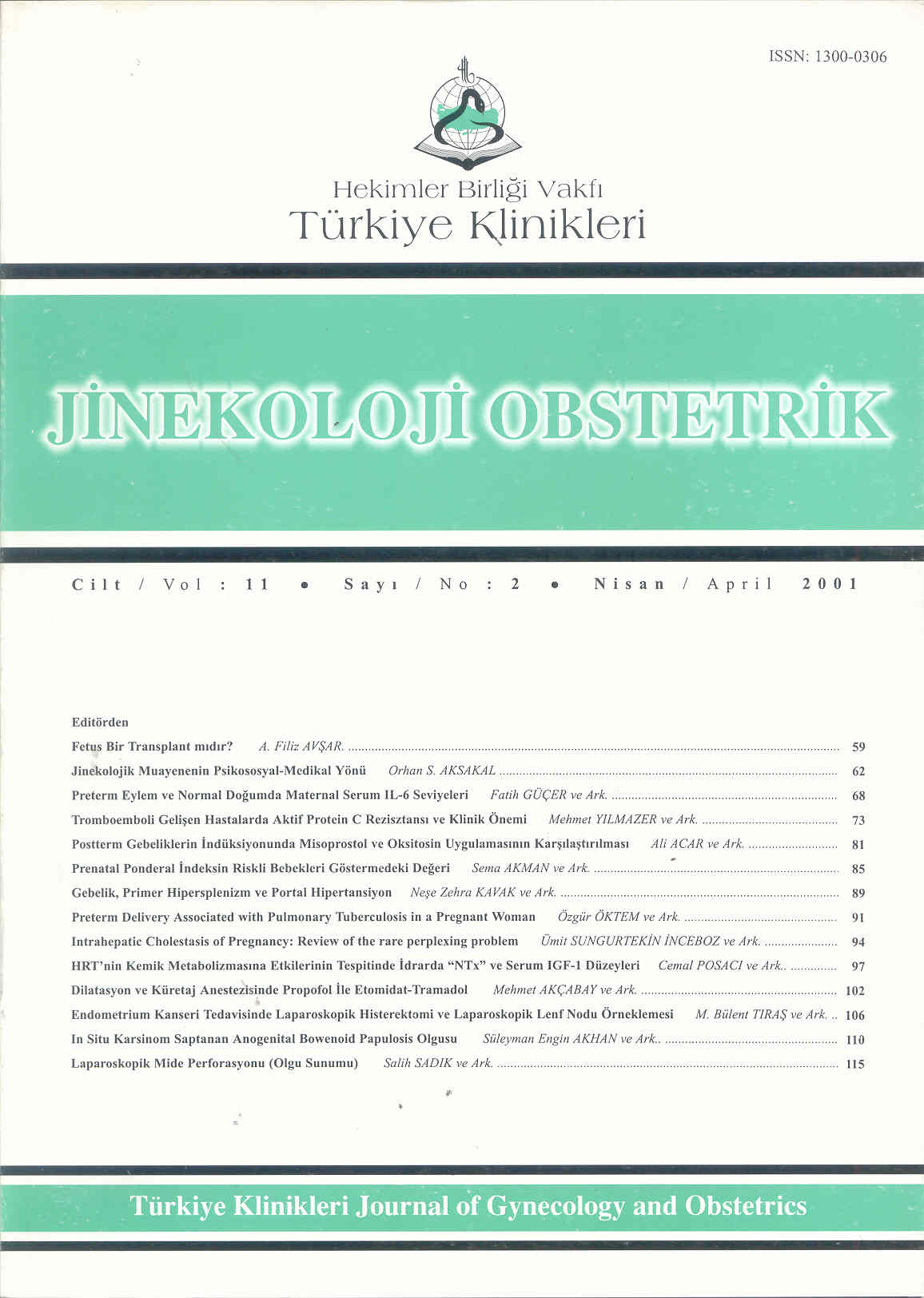Open Access
Peer Reviewed
ARTICLES
3107 Viewed1215 Downloaded
The Effect Of HRT With / Without Alendronate On Bone Metabolism In Postmenopausal Women As Assessed By Urinary NTx And Serum IGF-1 Levels
Postmenopozal Hastalarda HRT'nin Kemik Metabolizmasına Etkilerinin Tespitinde İdrarda
Turkiye Klinikleri J Gynecol Obst. 2001;11(2):97-101
Article Language: TR
Copyright Ⓒ 2025 by Türkiye Klinikleri. This is an open access article under the CC BY-NC-ND license (http://creativecommons.org/licenses/by-nc-nd/4.0/)
ÖZET
Amaç: "İdrar çapraz bağlı N-telopeptid" (NTx) kemik resorbsiyonunun spesifik markeridir. İnsülin benzeri büyüme faktörü-1 (IGF-1)in de kemik formasyonunu stimüle ettiği düşünülmektedir. Bu çalışmada altı aylık hormon replasman tedavisi (HRT) ile idrar NTx ve serum IGF-1 düzeylerinde oluşan değişiklikleri ve kemik mineral yoğunluğu <100mg/cm3 olan olgularda tedaviye alendronat eklenmesinin bu sonuçlara etkisini değerlendirmek amaçlandı. Materyel ve Metod: Çalışmaya doğal olarak menopoza girmiş toplam 66 hasta dahil edildi. Birinci gruptaki 23 hastaya oral Estrogen+Progesteron (E+P), ikinci gruptaki 22 hastaya ise transdermal E+P tedavisi uygulandı. üçüncü grup ise kemik mineral yoğunluğu 100ün altında olan ve oral E+P yanı sıra alendronat verilen 21 hastayı kapsıyordu. Bulgular: Çalışma gruplarında tedavi öncesi ve 6 aylık tedavi sonrası serum IGF-1 düzeyleri arasında anlamlı farklılık saptanmadı (p>0.05). Tedavi sonrası idrar NTx değerleri her 3 grupta da bazale göre anlamlı olarak düşük bulundu (p<0.05). Ancak NTx düzeyindeki azalmanın gruplar arasında istatiksel anlamlılık göstermediği belirlendi (p>0.05). Alendronat tedavisiyle ilave bir azalma gözlenmedi (p>0.05). Sonuç: Sonuç olarak altı aylık HRT ile görülen idrar NTx düzeyindeki azalma kemik yıkımındaki azalmayı göstermektedir ve bu durum HRTnin veriliş yolundan bağımsızdır. IGF-1 ise kemik yapım markeri olarak değerli bulunmamıştır.
Amaç: "İdrar çapraz bağlı N-telopeptid" (NTx) kemik resorbsiyonunun spesifik markeridir. İnsülin benzeri büyüme faktörü-1 (IGF-1)in de kemik formasyonunu stimüle ettiği düşünülmektedir. Bu çalışmada altı aylık hormon replasman tedavisi (HRT) ile idrar NTx ve serum IGF-1 düzeylerinde oluşan değişiklikleri ve kemik mineral yoğunluğu <100mg/cm3 olan olgularda tedaviye alendronat eklenmesinin bu sonuçlara etkisini değerlendirmek amaçlandı. Materyel ve Metod: Çalışmaya doğal olarak menopoza girmiş toplam 66 hasta dahil edildi. Birinci gruptaki 23 hastaya oral Estrogen+Progesteron (E+P), ikinci gruptaki 22 hastaya ise transdermal E+P tedavisi uygulandı. üçüncü grup ise kemik mineral yoğunluğu 100ün altında olan ve oral E+P yanı sıra alendronat verilen 21 hastayı kapsıyordu. Bulgular: Çalışma gruplarında tedavi öncesi ve 6 aylık tedavi sonrası serum IGF-1 düzeyleri arasında anlamlı farklılık saptanmadı (p>0.05). Tedavi sonrası idrar NTx değerleri her 3 grupta da bazale göre anlamlı olarak düşük bulundu (p<0.05). Ancak NTx düzeyindeki azalmanın gruplar arasında istatiksel anlamlılık göstermediği belirlendi (p>0.05). Alendronat tedavisiyle ilave bir azalma gözlenmedi (p>0.05). Sonuç: Sonuç olarak altı aylık HRT ile görülen idrar NTx düzeyindeki azalma kemik yıkımındaki azalmayı göstermektedir ve bu durum HRTnin veriliş yolundan bağımsızdır. IGF-1 ise kemik yapım markeri olarak değerli bulunmamıştır.
ANAHTAR KELİMELER: Hormon replasman tedavisi, IGF-1, NTx, osteoporoz
ABSTRACT
Objective: Urinary cross-linked N-telopetid of type 1 collagen (NTx) is a specific marker of bone resorption. Insulin-like Growth Factor-1 (IGF-1) is thought to be a stimulator of bone formation. The aims of this study are to determine the changes on levels of urinary NTx and serum IGF-1 after the six mounts HRT and the effects of additional alendronate therapy for osteoporotic women. Materials and Method: 66 posmenopausal women were enrolled into this study. First group consisted of 23 women who were treated with oral Estrogen + Progesterone (E+P), second group consisted of 22 women who were treated with E+P transdermally. Third group consisted of 21 women with bone mineral density value <100mg/cm3 and treated with oral E+P +alendronate. Results: Serum basal and post therapy IGF-1 levels were not different in all groups (p>0.05). Post treatment urinary NTx were significantly lower than basal levels in all three groups (p<0.05). But the decline of NTx were not significantly different among groups (p>0.05). There was no additinal decrease in the levels of NTx with alendronate therapy (p>0.05). Conclusions: The decline of NTx after HRT for six mounts showed the decrease of bone resorption and this is not related with the route of administration. IGF-1 is not considered as a suitable marker of bone formation.
Objective: Urinary cross-linked N-telopetid of type 1 collagen (NTx) is a specific marker of bone resorption. Insulin-like Growth Factor-1 (IGF-1) is thought to be a stimulator of bone formation. The aims of this study are to determine the changes on levels of urinary NTx and serum IGF-1 after the six mounts HRT and the effects of additional alendronate therapy for osteoporotic women. Materials and Method: 66 posmenopausal women were enrolled into this study. First group consisted of 23 women who were treated with oral Estrogen + Progesterone (E+P), second group consisted of 22 women who were treated with E+P transdermally. Third group consisted of 21 women with bone mineral density value <100mg/cm3 and treated with oral E+P +alendronate. Results: Serum basal and post therapy IGF-1 levels were not different in all groups (p>0.05). Post treatment urinary NTx were significantly lower than basal levels in all three groups (p<0.05). But the decline of NTx were not significantly different among groups (p>0.05). There was no additinal decrease in the levels of NTx with alendronate therapy (p>0.05). Conclusions: The decline of NTx after HRT for six mounts showed the decrease of bone resorption and this is not related with the route of administration. IGF-1 is not considered as a suitable marker of bone formation.
MENU
POPULAR ARTICLES
MOST DOWNLOADED ARTICLES





This journal is licensed under a Creative Commons Attribution-NonCommercial-NoDerivatives 4.0 International License.










